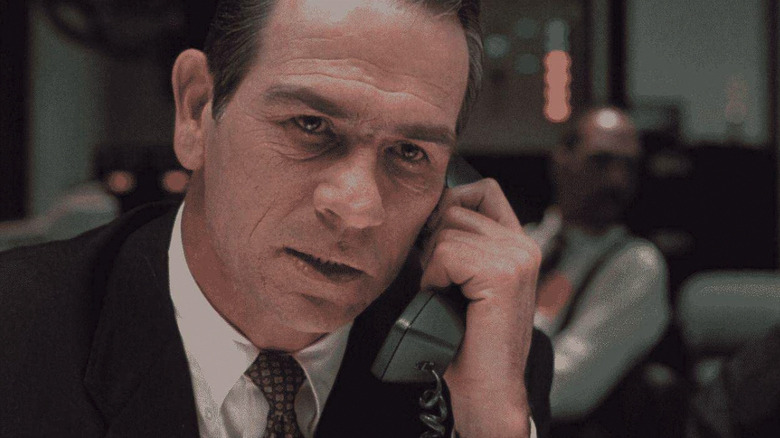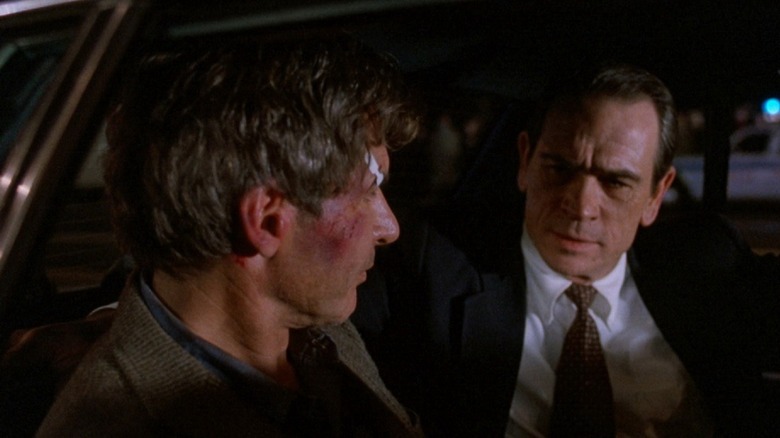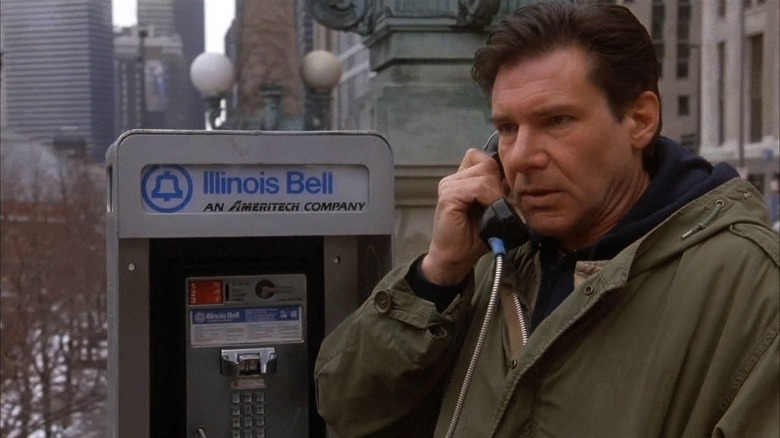The Fugitive's Original Script Had A Villain Twist For Tommy Lee Jones
The 1963 TV series "The Fugitive" was a massive success in its initial four-season run, and became something of a pop cultural touchstone. The premise was a grabber: Dr. Richard Kimble (David Janssen) has been arrested and convicted for the murder of his wife, a crime he didn't commit. Dr. Kimble slips the authorities and goes on the lam, eager to track down the real killer and prove his innocence. All he knew was that the killer had one arm. On Dr. Kimble's tail — the Javert to his Valjean — was Lieutenant Philip Gerard (Barry Morse), who didn't much care if Kimble was guilty or innocent; he merely sought to apprehend him and let the law work itself out.
30 years later, "The Fugitive" would be adapted into a massively successful and acclaimed feature film starring Harrison Ford as Kimble and Tommy Lee Jones as the re-named Sam Gerard, a U.S. Marshal. "The Fugitive," directed by Andrew Davis and written by David Twohy and Jeb Stuart, was nominated for seven Academy Awards, including Best Picture. Jones won Best Supporting Actor. The film was the second biggest hit of the year, behind only "Jurassic Park." "The Fugitive" made $353 million worldwide (and that's in 1993 dollars).
This year, the film is celebrating its 30th anniversary, and a piece in the latest issue of Empire Magazine details how the "Fugitive" feature film had been optioned decades before its release and went through extensive and repeated changes during its lengthy pre-production. Story beats and character twists were picked up and dropped with staggering regularity over the years, including a notable twist that would have — completely illogically — made Gerard the film's villain.
'It made no sense'
According to the retrospective, producer Arnold Kopelson had been trying to finalize a "Fugitive" movie for a long, long time, and had managed to amass 25 different drafts in just the previous five years. Harrison Ford had already been cast as Dr. Kimble, but "The Fugitive" didn't yet have a script or a director. When Ford saw Andrew Davis' "Under Siege" one weekend in 1992, however, Davis was immediately hired. Davis recalled that his meetings with Kopelson were great, but that the script he was handed was, to use his word, "terrible." In draft 25, Davis revealed, Gerard was the villain. It seems that the extensive rewrites that led up to draft 25 drifted quite a long way from the source material. Davis explained:
"[Gerard had] hired the one-armed man to kill Kimble, after Kimble screwed up an operation on Gerard's wife. [...] It made no sense. But Harrison had committed to the movie, and his viewpoint was: 'Hey – we'll fix the script.'"
And fix it they did. Davis immediately ditched the idea that Gerard should be the villain, as well as the notion that Kimble had done something horribly wrong to warrant revenge. Indeed, with a heroic actor like Ford in the lead role, Davis felt that Dr. Kimble should remain a righteous and innocent character, making the eventual murder accusation all the more shocking. Davis called his sister Josie, a nurse, and she suggested the theme of the movie. Davis recalled:
"I said, 'Josie, what could a doctor do that would get him in a lot of trouble?' She talked to some bright young resident at her hospital, who said, 'What if there's a dangerous new drug on the market and the doctor says this drug is bulls***?' So, that became the plot."
A wise change.
Dr. Kimble vs. Big Pharma
Andrew Davis admitted that, in making a suspicious drug company's sinister dealings the real reason why Dr. Kimble was framed, he effectively made Big Pharma the villain of "The Fugitive." In 1993, it was an interesting plot twist. Since then, the idea of an evil drug company has only become more and more relevant. Davis said that he unwittingly "picked a bad guy that would be around for years."
However, once the general story had been settled on — and Harrison Ford approved — rewrites continued during production. Davis and Andrew Kopelson continued to tweak and refine certain elements. Another idea that was mercifully scrapped was a romantic subplot wherein Dr. Kimble instigated an on-the-lam affair with Dr. Anne Eastman, the character played by Julianne Moore. Kopelson felt that a man who is trying to hunt down the killer of his wife should, perhaps, be in mourning for her rather than moving on to a new romantic partner so quickly:
"Julianne Moore plays a doctor, and there was meant to be this scene where Harrison goes back to her place to take a shower. But my producing partner, Peter MacGregor-Scott, said, 'Andy, we can't do this: this guy is in mourning for his wife!' I said, 'You're right.' Kopelson called Julianne to tell her we weren't doing those scenes."
Through massive tinkering, something great was eventually constructed. Most productions keep on altering their final script, often well into shooting, to make sure scenes function and plots make sense. For most major studio releases, dozens of people contribute to the screenplays, even if only one or two writers are ultimately credited. It's almost as if writers ought to be supported in the industry.


